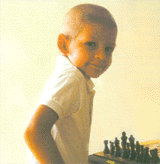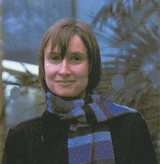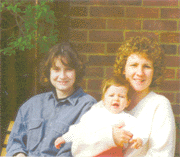Originally published in December 2002 icon
Growing Out Of Childhood Leukaemia
William Chadwick and Louise Emberson are looking forward to a long life, living proof that children with leukaemia can be cured.

William’s Story
At four, William Chadwick was diagnosed with ALL (Acute Lymphoblastic Leukaemia). He’s now 20 and a first year English student at Sussex University.
He’d scarcely tacked the posters on his bedsit wall before committing to direct a Pinter play and trying out for the university football team.
William also skis, plays tennis and squash, and went skydiving during his gap year travels through South East Asia and Australia. He has set his career sights on writing, journalism or the theatre.
"One day when I was three or four I was sent off on a race with my friend. Freddie. He came back all red and sweaty, but my face was still white as a sheet. Some unerring instinct prompted my mother to say "I think he’s not well. I think he might have leukaemia."
The next day she took me to the doctor and within hours I was in Great Ormond Street Children’s Hospital.
I have only hazy memories of my eight months there, mostly feeling very weak and tired. They were always digging needles into me, giving me bone marrow and lumbar punctures.
With chemo (I had the drug Vincristin) I was always sick at least 10 times and under anaesthetic I had the most horrible recurring nightmare of white-tiled hospital walls closing in while I searched for my parents and tried to find a way out.
I remember my parents and my grandmother trying to shove carrot juice down my throat and also of running down a corridor with my IV stand, which I somehow managed to rip out of my arm. Blood spurted everywhere. But, as long as people kept giving me toys - especially Lego - I was happy enough.

They were always digging needles into me, giving me bone marrow and lumbar punctures

My mother stayed with me the whole time and my father who was then in publishing would read to me from an endless supply of new books It’s ironic that my parents were warned the treatment might stunt my growth: I’m six foot four!
My chances of recovery were never, of course, mentioned in my hearing, but my father was told they were 60 per cent. About 10 years ago I came across my father’s college yearbook where alumni were catching up on their news. My father’s entry ran "I’ve had a son and he almost died of leukaemia".
That was the first time I realised how close I’d come.
I must have been on the road to recovery when my hair fell out, because I was out of hospital and once again playing at Freddie’s house.
It started coming out in handfuls which I left in big piles all around the place. His mum had a fit. I thought it was kind of cool. I felt a bit self-conscious though, when I went back to school. Not that there was any teasing or bullying: the teacher told the class ’Listen, William’s not very well and it’s meant he has no hair so be nice to him.’ And they were, pretty much.
My parents split up a while after I recovered, but the important thing is that they always told me they loved me. I’ve always been very conscious that my parents value me a lot.
For a while they were probably extra-protective (I still had colds and flu a lot) which turned me into a bit of a nasty brat when I was seven or eight. Luckily my half- sister, Allegra, came along - and I lost a lot of that exclusive attention.

Having leukaemia has left me with a fairly dark, realistic, life
philosophy

As you grow up, memory fades and the leukaemia has ceased to be any big deal. I don’t tell that many people about it now, unless for some reason the subject comes up. I still have annual check-ups - they are really just progress reports as they don’t even take blood anymore.
I’m probably more aware of my own mortality than most of my peers. I wouldn’t take unnecessary risks or go looking for trouble.
Maybe this makes me a little less adventurous, though I went skydiving in Australia. If you can jump out of a plane you can do just about anything.
Having leukaemia has left me with a fairly dark, realistic, life philosophy.
Just when things are going really well and you think nothing’s going to go wrong, it does. You just have to accept that and get on with it. But some way down the line, something good will probably come out of the bad.
I believe in living this life to the full because I don’t think there’s another one. I don’t see the point of waiting for something good to happen next time around. So I try and I take full advantage of what I’ve got right now, putting in and getting the most out of every day.

Louise’s Story
Louise Emberson was 13 when diagnosed with acute myeloid Ieukaemia. She went remission only to relapse again four years later.
She needed a bone marrow transplant, but no one in the family proved a suitable match.
That’s when Sarah May, an unrelated donor on the national register came into the picture. Thanks to her, Louise recovered and the two women became close friends.
Louise, now 29, recently finished a Ph.d at the University of Kent at Canterbury. She worked with a research group aiming to develop T-cells that would target and destroy leukaemia infected cells.
Her present, post-doctoral research involves developing leukaemiasped fic agents attached to a radioisotope which delivers radiation selectively to leukaemia cells. So the healing gift that Sarah made Louise could, in time, pass on to other childhood sufferers.
I had a great childhood in Cornwall, until at 13, I had colds all winter. I felt lethargic and was forever tearful. I caught mumps really badly and never really picked up.

To be honest, the diagnosis came almost as a relief

Mum took me to the doctor for a blood test, and to be honest, the diagnosis - acute myeloid leukaemia came almost as a relief.
Having felt unwell for so long, I was glad to know I wasn’t imagining it.
The leukaemia type I had accelerates fairly quickly, but nobody ever hinted that I might not survive.
I was warned that treatment would make me feel worse before I was better, but I had no real perception of what was to come during three courses of chemotherapy at the Bristol Children’s Hospital.
The third bout was particularly toxic as they had trouble getting me into remission. It was a rough time, I suffered constant infections and was very sick. I had mouth ulcers, and was fed intravenously. But though it sounds bizarre, I remember fun and jokes between chemo. I once put shaving cream on the adolescent ward door knob.
Throughout my three months there, Mum stayed with me, sleeping in a CLIC (Cancer and Leukaemia in Childhood) house for families of patients. It’s one of a number set up by this charity as a home from home.
At weekends, the rest of the family would come and stay too.
Having them around helped me stay positive. I missed almost a school year, but I had a wonderful home tutor and was in remission long enough to get five A grades among my GCSEs.

Luckily they’d caught the illness very early

I relapsed again the spring. I was 17, and a monthly check picked up a low platelet count.
Luckily they’d caught the illness very early: I only had 20 per cent of affected cells instead of the 90 per cent I’d had the first time round.
But this time I was much more distressed; I’d been clear long enough for leukaemia to recede into an occasional niggle at the back of my mind.
I was also adult enough to ask ’Why me?’. There’s no answer: you either get on with life as it is, or let it beat you.
A large part of overcoming an illness like mine is mental attitude.
In June that year I had a bone marrow transplant and that’s how Sarah May - an unrelated donor - became vital. Although I’m one of five children, only two are even half-siblings and Mum, sadly was not a donor match either.
I was curious about my generous stranger, but told I must wait a year to learn her identity. Sarah actually sent me flowers (’from your donor’) before the surgery - a gesture that really touched me.
Preparation for the transplant knocked me for six again: I had total body irradiation combined with intense chemo to knock out my whole immune system so it would not reject the transplant and to get rid of any lasting leukaemic cells.
I think I knew that it was a risky procedure, and I did register the thought that I might not come back. But I was always going to give it my best shot.
After receiving Sarah’s marrow, I was isolated for three weeks, feeling poorly, on steroids with no red cells, no energy, not eating. I couldn’t have visitors but cards came in reams, pinned to the outside of my cubicle window, so I could read through the glass.
I was allowed out relatively fast: doctors could see that as my immune system and blood cells were returning, the transplant was taking.

My donor actually sent me flowers before the surgery - a gesture that really touched me

I was pretty much back to normal by Easter of my A level year when I spent a weekend with Sarah and her husband Roger.
Both being so keen, we were allowed to meet before the full, prescribed year.
Sarah’s very down to earth and still plays down what for me was a huge, amazing thing for her to have done. We’ve kept in touch ever since, bonded by something beyond friendship.
I’m perfectly well now, but I still feel a bit uneasy before yearly check-ups, though logically the chances of problems are now increasingly slim. I live quite healthily: I don’t eat red meat, just fish and chicken and I drink soya milk.
My theologian boyfriend is vegan. so we eat a lot of nut roasts, vegetables and fruit. I go to the gym, swim, play badminton and squash.
Unfortunately combined radio and chemo therapy triggered an early menopause, so I take calcium and I’m on HRT as a safeguard against osteoporosis, which I know slightly increases the risk of breast cancer.
Otherwise my twenties have passed like anyone else’s - and I’ve taken my dad’s advice to seize whatever opportunities appear, because they might not come again. I spent a year of my biological science degree in America and finished up driving across th States.
By then - 1996 -knew my Ph.D must focus or leukaemia treatment, having been on the patient’s side gives added motivation.
There’s no guarantee, but I hope our work here in Canterbury will eventually improve leukaemia treatment. Conventional chemo not only knocks out leukaemia cells, but many others in your immune system. That’s what makes patients so sick.
The work I’n doing is all about targeting Ieukaemia cells selectively.
I wouldn’t now change any of my past, because it’s made me what I am. It’s sad that I can’t have children, but when ready, I could always consider adopting. I’d far rather be alive, having to make a couple of sacrifices, than not be alive at all. Here I am with my whole future ahead of me, able to do anything I want.

Sarah May
Sarah May, now 38, donated bone marrow to Louise, thus redeeming her health and future. Sarah was an office manager in an architect’s office at the time, but has since moved from Sussex to rural mid-Wales where she and husband Roger are raising their four children.
"Through Louise I feel I’m part of a great success story. I get very emotional just talking about it. But please don’t make me out to be heroic.
I only did what anyone else who was able would have done. I became a blood donor years ago, largely to get over my fear of needles.
Giving blood one day, I saw a poster for bone marrow donation and asked to know more. All I had to do was give an extra blood sample for analysis, so I went on the Register there and then.
Five years went by before I was asked to help an unnamed young girl, and screened at a large London hospital to see if I was fit for surgery.
Our dual surgeries, in Bristol, were scheduled for three weeks before my wedding.
We were, astoundingly, such a good match that we might have been sisters.
As well as a general anaesthetic, I was to have an epidural to block the pain when I woke up.
Just beforehand I felt very nervous, but there was no way I was not going ahead.

Would I give marrow again? Absolutely!

You’re not about to say ’Oh it’s going to hurt, so I can’t do it. The other person can die.’
I was off work for a week, washed out from the anaesthetic, and initially I felt very low: I’d done this thing for someone I didn’t know but couldn’t stop thinking about.What if we’d both been through all this -and she died anyway? By my wedding day I was fine though there were tears when my father mentioned what I’d done in his speech.
Would I give marrow again? Absolutely!
From our first meeting there’s been a special bond between me and Louise.
I was pregnant with my first child when she came for the weekend and gave me a poetry book inscribed ’Thank you for giving me the gift of life.’
Leukaemia ~ The Facts:
500 children each year are affected by leukaemia - the most common form of childhood cancer. Massive numbers of white blood cells (lymphocytes) take over the bone marrow where normal blood cells are produced, and spill out into the bloodstream. Researchers now suspect that leukaemia has no single cause but develops due to a double, or triple ’whammy’ factor. Some babies develop a genetic propensity in the womb, and it’s suspected that leukaemia may then develop as a rare response to infection. Forty years ago a leukaemia diagnosis almost always proved fatal, but now more than seven out of ten children recover. Symptoms include fatigue, bruising, unexplained fever, persistent infections, and bleeding from gums or gut. Eighty five per cent of affected children have Acute Lymphoblastic Leukaemia (ALL) which affects the lymphocytes. More boys than girls get ALL and the peak age for diagnosis is between two and four. Only 15 per cent of young patients have Acute Myeloid Leukaemia (AML) which affects the white cells, except lymphocytes, less often the red cells and platelets.
Most ALL patients, like William Chadwick, need drug treatment only. AML requires rapid treatment to be most effective, but chemotherapy, albeit aggressive, is now also increasingly successful. Bone marrow (also known as stem cell) transplantation is primarily used to treat the 20-25 per cent of AML children who have subsequently relapsed. Generally, children who go into early remission have a higher ultimate cure rate.